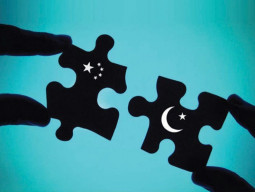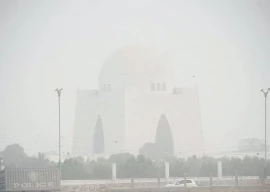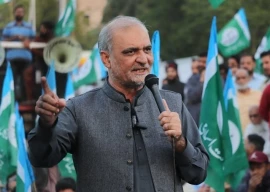
The government faces an economic crisis which, if allowed to persist, could place severe stresses on the society and state. The government must now stand and deliver on the economic front — not only to secure its own political future but the future of the people of Pakistan. Let us identify some of the main features of the challenges at hand and the medium term initiatives that can be taken to place Pakistan on the path of economic prosperity.
The most important characteristic of the current crisis is that persistent recession is combined with acute pressures on the balance of payments front. This is different from earlier episodes of balance of payments crises, which occurred at the pinnacle of high growth periods. A balance of payments crisis with recession is mainly because most of the public sector outlays of the previous government (65 per cent) have been on import intensive, but non-productive, expenditure.
The severity of the balance of payments crisis can be judged by the fact that the State Bank of Pakistan’s reserves at about seven billion dollars can provide cover for only six weeks of imports whereas, the safe level is for 12 weeks of imports. This means that Pakistan faces a dangerous exchange rate fragility. Any exogenous event that undermines confidence could trigger a disastrous exchange rate collapse that could fuel hyper inflation.
The second and related feature of the current crisis is that recession is occurring simultaneously with an unsustainable fiscal deficit (seven per cent of GDP). A high fiscal deficit in itself is not a cause for alarm. If it is being generated by productive investment by the government in infrastructure for example, the resultant income stream could, in time, bring the budget deficit down through the high revenues that accompany high GDP growth. But, if the fiscal deficit has been generated by non-productive expenditure with no stimulation to GDP growth as in the present case, then such a fiscal deficit takes the country to the verge of bankruptcy.
So, how do we get out of this syndrome of recession occurring simultaneously with unsustainable fiscal and balance of payments deficits? Four initiatives are required which, if undertaken, could place Pakistan on the path to prosperity.
First, fiscal space has to be created to undertake electricity generation, gas production and water storage and conservation measures. These constitute the three critical physical constraints to economic growth. In the short run, a sovereign Pakistan bond should be floated to mobilise five billion dollars from the global capital market. At the same time, we need to negotiate with the IMF to reschedule the five billion loan repayments due over this fiscal year.
Second, in the medium term, the energy mix has to be changed in favour of cheaper hydroelectric and local coal-based power production. The financing of these projects requires seeking foreign investment from China, India, the Middle East and multilateral agencies, such as the World Bank, the ADB and the Saarc development fund. Simultaneously, Pakistan should pursue an integrated South Asian grid that supplies electricity to energy lacking South Asian countries and jointly harnessing the considerable hydroelectric potential of the Himalayas, the Karakoram and the Hindu Kush.
Third, gas shortages in Pakistan can be overcome by establishing gas pipelines from Iran, Turkmenistan and Kazakhstan that could supply gas not only to Pakistan but also Afghanistan, India, Bangladesh and Myanmar in a new North-South, West-East gas network for South Asia.
Fourth, these new networks of electricity and gas in South Asia could be combined with setting up a rail and road network that could link China with Pakistan and indeed all of South Asia. Roads and railways could run from China through Peshawar to Gwadar, Karachi and also to Delhi, Dhaka and further east to Myanmar.
Such projects, by linking China with South Asia and Asean countries, would generate synergies that could catapult Pakistan onto a new trajectory of growth. This would transform Pakistan’s economy and make South Asia, together with China, into the greatest economic power house in human history.
Published in The Express Tribune, June 22nd, 2013.
Like Opinion & Editorial on Facebook, follow @ETOpEd on Twitter to receive all updates on all our daily pieces.
COMMENTS (5)
Comments are moderated and generally will be posted if they are on-topic and not abusive.
For more information, please see our Comments FAQ






















































An earnest plea of an enlightened but worried professor. Who would contest the economic rationality and potential efficacy of the proposed policy measures except right wing hate mongers whose politics hinges on optimizing hostilities. This mind set will never ever allow Pakistan to cultivate the economic benefits of regional trade and close economic cooperation. Putting political house in order precedes all other considerations. What is needed a down to earth govt selflessly busy in mundane affairs of state and governance, abandoning and renouncing lofty ideals of seeking strategic depths everywhere. Expensive and unrealistic projects like "Kshmir banaga Pakistan" and "Taibanized Afghanistan" with an extremely negative IRR have ruined our economy polity and society. When the very survival is at stake, GDP growth rates and budget deficits are less of a concern.
Dr Sahib Succinct Economic Analysis and conclusion. However, the underlying problem as usual remains political, and it its roots social, rather than of " positive economics". 1. IMF will definitely prescribe its biased medicine of belt tightening for pakistanis, to rephrase a famous economists' words, when most of us are too poor to wear belts. So will the new govt will play hard ball with IMF and its main contributor US to save us. 2. Does the govt has what it takes to push through power projects like Kalabagh Dam? 3. How will the PML- N govt. find the will to undertake gas pipeline with Iran with its bent towards Saudi Arabia? So until the Govt finds its will, the economic problems just wont go away.
Dr. sb has assumed a perfect world in which Pakistani and Indian politicians can work together. Dr. sb has also assumed that Pak's sovereign bond, knowing that Pakistan's S&P rating is close to junk, can easily be floated in the international market. Question is how to get out of stagflation .. apparently most of the economic machinery in Pakistan is not capable of dealing with such a problem.
Pakistan has to get rid of its hate mindset, hosting terrorists, rise above Religion etc. Are you ready to do all this? Remember, 1000 cuts.. Now why do you want prosperity, when you wanted to eat grass anyways.
Dear Sir, I agree to what you have said, and it makes perfect economic sense, but I do feel that you have over simplified a lot of things. The geo-political considerations, and impact on Pakistans foreign policy for pursuing such projects would be immense, and arguably it can be positive, but the political will needed to execute such project is a far cry, we cannot even muster the will to solve for example Karachis problems !